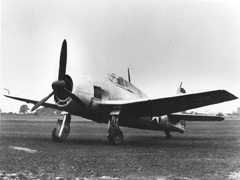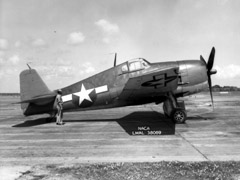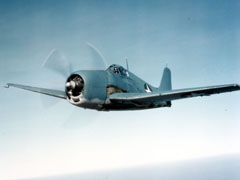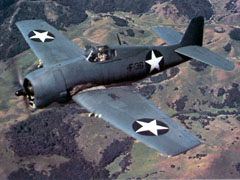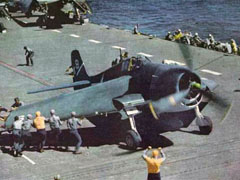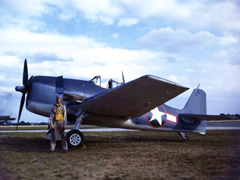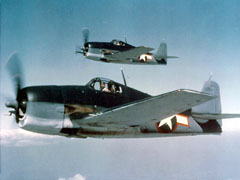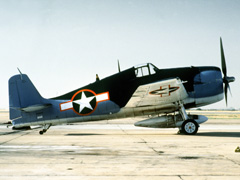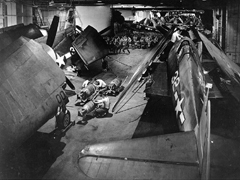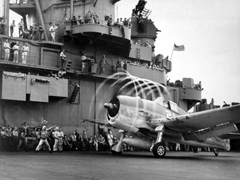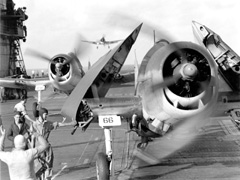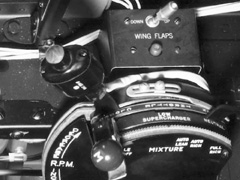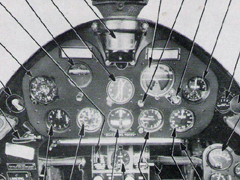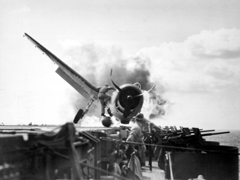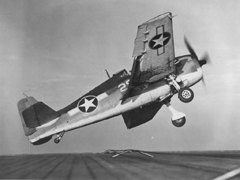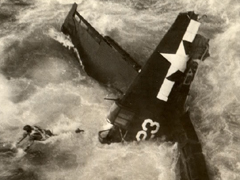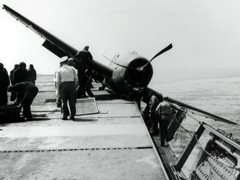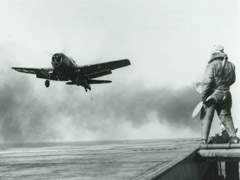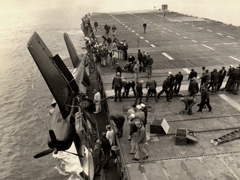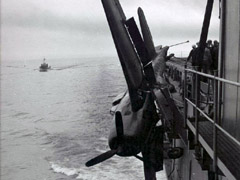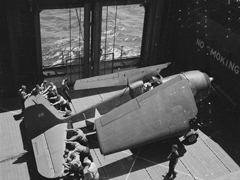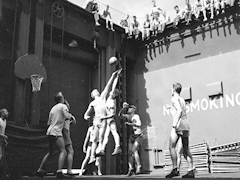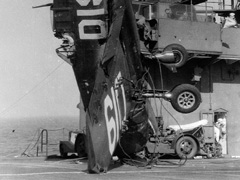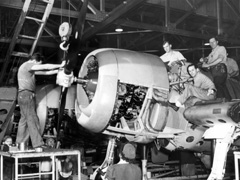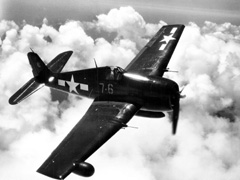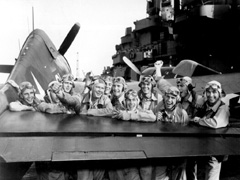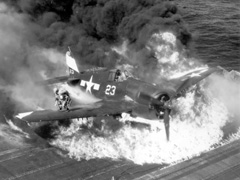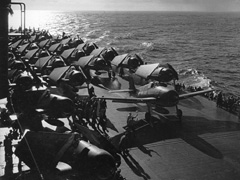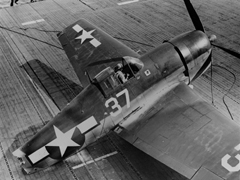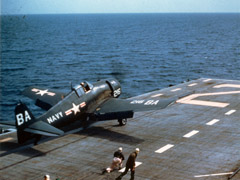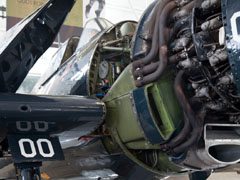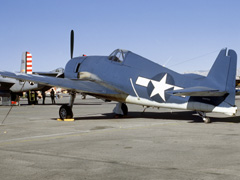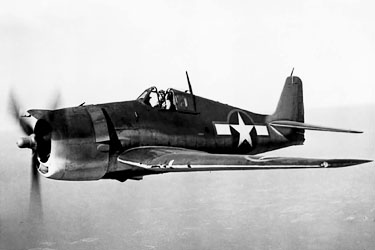 |
|
Aircraft Type |
Carrier-borne fighter of US Navy |
|
Manufacturer |
Grumman Aircraft Engineering Corporation |
|
Engine |
Radial 18-cylinder, air-cooled 2,804 cid |
|
Horsepower |
2,000 hp (1,491 kW) at 2,700 rpm |
|
Weight |
9,238 lb (4,190 kg) empty |
|
Max Speed |
380 mph (621 km/h) at 23,400 ft |
|
Configuration |
Single
seat (pilot) |
|
|
| |
|
The Grumman F6F Hellcat was a
carrier-based fighter aircraft conceived to replace the
earlier F4F Wildcat in United States Navy (USN) service. The
Hellcat was an former rival of the faster Vought F4U Corsair
for use as a carrier based fighter. However, the Corsair had
significant issues with carrier landing that the Hellcat did
not, allowing the Hellcat to steal a march as the Navy's
dominant fighter in the second part of World War II, a
position the Hellcat did not relinquish. The Corsair instead
was primarily deployed to great effect in land-based use by
the U.S. Marine Corps.
Although the F6F resembled the Wildcat, it was a
completely new design, powered by a 2,000 hp Pratt & Whitney
R-2800, the same powerplant used for both the Corsair and
the United States Army Air Force's (USAAF) Republic P-47
Thunderbolt fighters. Some military observers tagged the
Hellcat as the "Wildcat's big brother".
The F6F was best known for its role as a rugged,
well-designed carrier fighter which was able, after its
combat debut in early 1943, to counter the Mitsubishi A6M
Zero and help secure air superiority over the Pacific
Theater. Such was the quality of the basic simple,
straightforward design, that the Hellcat was the least
modified fighter of the war, with a total of 12,200 being
built in just over two years.
Hellcats were credited with destroying 5,223 aircraft
while in service with the U.S. Navy, U.S. Marine Corps and
the Royal Navy's Fleet Air Arm This was more than any other
Allied naval aircraft. Postwar, the Hellcat was phased out
of frontline service, but remained in service as late as
1954 as a night fighter.
The last Hellcat rolled out in November 1945, the total
production being 12,275, of which 11,000 had been built in
just two years. This high production rate was credited to
the sound original design, which required little
modification once production was underway.
|
|
|
|
|
|
|
Specifications F6F-5 Hellcat
Bureau of Aeronautics Navy Department (Rev. 1-1949)
| General characteristics |
| |
|
|
| Crew: |
|
One pilot |
| Length: |
|
33 ft 7 in (10.24 m) |
| Wingspan: |
|
42 ft 10 in (13.06 m) |
| Height: |
|
14 ft 5 in (4.394 m) |
| Tread: |
|
11 ft 0 in (3.353 m) |
| Wing area: |
|
334 ft² (31 m²) |
| Empty weight: |
|
9,238 lb (4,190 kg) |
| Combat weight: |
|
12,740 lb (5,779 kg) |
| Max. takeoff: |
|
15,300 lb (6,940 kg) |
| Powerplant: |
|
1 × Pratt & Whitney R-2800-10W "Double
Wasp" 2,000 hp (1,491 kW) twin-row radial engine with
two-stage two-speed supercharger |
| Propellers: |
|
3-blade Hamilton Standard, dia. 13
ft 1 in (4.0 m) |
| |
|
|
| Performance |
| Top speed: |
|
330 kn (380 mph, 621 km/h) |
| Stall speed: |
|
73 kn (84 mph, 135 km/h) |
| Combat radius: |
|
820 nmi (945 mi, 1,520 km) |
| Rate of climb: |
|
3,500 ft/min (17.8 m/s) |
| Service ceiling: |
|
37,300 ft (11,370 m) |
| Time to altitude: |
|
7.7 min to 20,000 ft (6,100 m) |
| |
|
|
| Armament |
| Guns: |
|
Either 6× 0.50 in (12.7 mm) M2 Browning
machine guns, with 400 rounds per gun,
(All F6F-3, and most F6F-5) • or 2 ×
0.79 in (20 mm) cannon, with 225 rounds
per gun • and 4 × 0.50 in (12.7 mm)
Browning machine guns with 400 rounds
per gun (F6F-5N only) |
| Rockets: |
|
6 × 5 in (127 mm) HVARs, or 2 × 11¾ in
(298 mm) Tiny Tim unguided rockets |
| Bombs or torpedoes: |
|
1 × 2,000 lb (907 kg) bomb, or 1 ×
Mk.13-3 torpedo |
| Under
wing bombs: |
|
(F6F-5 had 2 additional weapons racks
either side of fuselage on wing
center-section) 2 × 1,000 lb or,
4 × 500
lb, 8 × 250 lb |
|
|
|
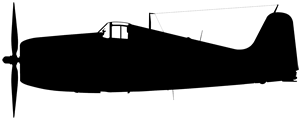 |
|
Aircraft silhouette |
|
|
|
|

|
Grumman Aircraft Engineering Corporation
Corporate logo |
|
|
|
|
|
|
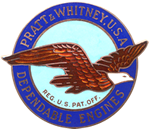 |
|
Pratt & Whitney USA |
|
|
| |
|
Engine Specifications
Pratt & Whitney R-2800-10W Double Wasp "B" Series
| General specs |
|
|
| Type: |
|
18-cylinder air-cooled twin-row supercharged
radial piston engine with water
injection |
| Bore: |
|
5.750 in (146.05 mm) |
| Stroke:
|
|
6.000 in (152.4 mm) |
| Displacement:
|
|
2,804 in³ (46 L) |
| Diameter:
|
|
52.8 in (1,342 mm) |
| Dry weight:
|
|
2,360 lb (1,073 kg) |
| |
|
|
| Components |
|
|
| Valvetrain:
|
|
Two overhead
valves per cylinder |
| Supercharger: |
|
Two-stage, two-speed, centrifugal type
supercharger |
| Reduction gear: |
|
2:1 |
| Fuel system:
|
|
One Bendix-Stromberg PT-13G6, downdraft,
pressure carburetor, 3-venturi |
| Fuel type:
|
|
100/130 octane gasoline |
| Cooling system:
|
|
Air-cooled |
| |
|
|
| Performance |
|
|
| Power output:
|
|
2,000 hp (1,491 kW) at 2,700 rpm for
takeoff, up to 2,250 hp (1,677 kW) "WEP" |
| Specific power:
|
|
0.71 hp/in³ (32.6 kW/L |
| Compression ratio: |
|
6.65:1 |
| Power/weight ratio: |
|
0.85 hp/lb (1.39 kW/kg) |
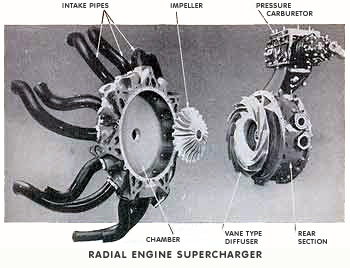 |
|
Pratt & Whitney |
|
R-2800-10W "Double Wasp" |
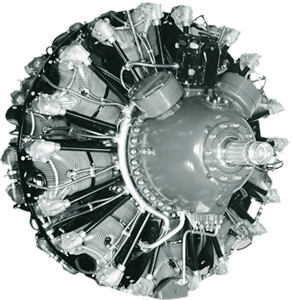 |
|
1939-1960 |
|
The radial engine was a twin-row, 2,804 cubic inch,
18-cylinder with
supercharger.
It weighed 2,360 pounds and delivered
2,000 hp at 2,700 rpm for takeoff, and
as much as 2,250 hp for combat power.
Designed with improved water injection
(designated "-W"), it generated an
additional 250 hp for about 15 minutes
of War Emergency Power, or combat power.
It became the backbone
of the American fighter fleet during
World War II, powering the Grumman F6F
Hellcat, the Vought F4U Corsair and the
Republic P-47 Thunderbolt. Production
for all series totaled 125,334 engines. |
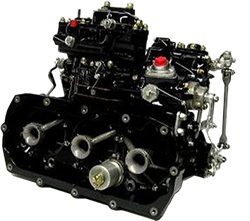
|
Bendix-Stromberg model PT-13G1
three-venturi, pressure carburetor |
|
|
| |
|
| |
Variants F6F
Hellcat
|
XF6F Prototypes
|
|
XF6F-1 |
First prototype, powered by a two-stage
1,600 hp (1,500 kW) Wright R-2600-10
Cyclone 14 radial piston engine. |
|
XF6F-2 |
The first XF6F-1 prototype revised and
fitted with a turbocharged Wright
R-2600-16 Cyclone radial piston engine.
R-2600 replaced by turbo-charged
R-2800-21. |
|
XF6F-3 |
Second prototype fitted with a two-stage
supercharged 2,000 hp (1,500 kW) Pratt &
Whitney R-2800-10 Double Wasp radial
piston engine. |
|
XF6F-4 |
One F6F-3 fitted with a two-speed
turbocharged 2,100 hp (1,567 kW) Pratt &
Whitney R-2800-27 Double Wasp radial
piston engine. |
|
XF6F-6 |
Two F6F-5s that were fitted with the
2,100 hp (1,566 kW) Pratt & Whitney
R-2800-18W radial piston engine, and
four-bladed propellers. |
|
|
|
Series Production
|
|
F6F-3 |
Single-seat fighter, fighter-bomber
aircraft, powered by a 2,000 hp (1,500
kW) Pratt & Whitney R-2800-10 Double
Wasp radial piston engine. (British
designations Gannet Mk. I then Hellcat
Mk. I) |
|
F6F-3E |
Night fighter version, equipped
with an AN/APS-4 radar in a fairing on
the starboard outer wing. |
|
F6F-3N |
Another night fighter version, equipped
with a newer AN/APS-6 radar in a fairing
on the starboard outer wing. |
|
F6F-5 |
Improved version with redesigned engine
cowling, new windscreen structure with
integral bulletproof windscreen, new
ailerons and strengthened tail surfaces;
powered by a 2,200 hp (1,640 kW) Pratt &
Whitney R-2800-10W (-W denotes Water
Injection) radial piston
engine. (British Hellcat Mk. II) |
|
F6F-5K |
A number of F6F-5s and F6F-5Ns were
converted into radio-controlled target
drones. |
|
F6F-5N |
Night fighter version, fitted with an
AN/APS-6 radar. Some were armed with two
20 mm (0.79 in) AN/M2 cannon in the
inner wing bays and four 0.50 in (12.7
mm) M2 Browning machine guns in the
outer. (British Hellcat N.F. Mk II) |
|
F6F-5P |
Small numbers of F6F-5s were converted
into photo-reconnaissance aircraft, with
the camera equipment being fitted in the
rear fuselage. |
|
Hellcat FR Mk II |
This designation was given to British
Hellcats fitted with camera equipment. |
|
FV-1 |
Proposed designation for Hellcats to be
built by Canadian Vickers; cancelled
before any built. |
|







